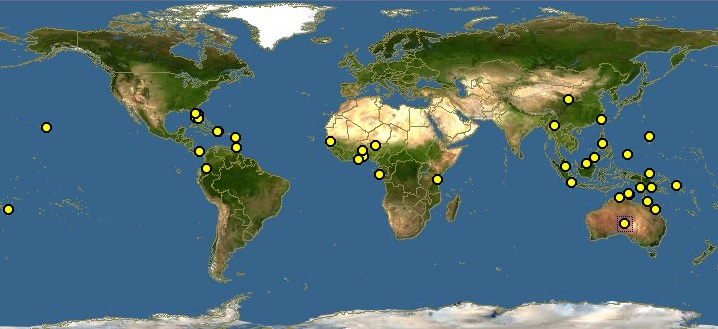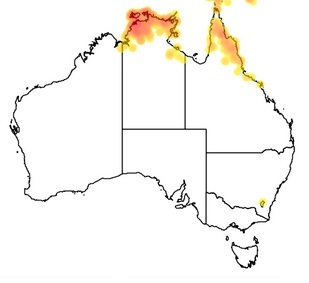Difference between revisions of "Acacia auriculiformis"
TheTraveler (Talk | contribs) m |
(→Geographic Distribution) |
||
| (9 intermediate revisions by one user not shown) | |||
| Line 1: | Line 1: | ||
<onlyinclude> | <onlyinclude> | ||
| − | {{botanics_info|File: | + | {{botanics_info|File:Acacia_Auriculiformis.jpeg|Acacia auriculiformis|5-MeO-DMT in stem bark (Lycaeum)}} |
</onlyinclude> | </onlyinclude> | ||
| − | + | == General Plant Info == | |
| + | '''''Acacia auriculiformis''''', commonly known as '''Auri, Earleaf acacia, Earpod wattle, Northern black wattle, Papuan wattle, Tan wattle''', is a fast-growing, crooked, gnarly tree in the family Fabaceae. It is native to Australia, Indonesia, and Papua New Guinea. It grows between to 15-30 m tall, with a trunk up to 12 m long and 50 cm in diameter. It has dense foliage with an open, spreading crown. The trunk is crooked and the bark vertically fissured. Roots are shallow and spreading. The generic name acacia comes from the Greek word ‘akis’ meaning a point or a barb and the specific epithet comes from the Latin ‘auricula’- external ear of animals and ‘forma- form, figure or shape, in allusion to the shape of the pod. | ||
| + | == Geographic Distribution == | ||
| + | [[File:auriculiformis-worldmap.jpg]] | ||
| + | |||
| + | |||
| + | |||
| + | [[File:auriculiformis-map.jpg]] | ||
| + | |||
| + | == Identification == | ||
| + | Leaves 10-16 cm long and 1.5-2.5 cm wide with 3-8 parallel nerves, thick, leathery and curved. | ||
| + | Flowers are 8 cm long and in pairs, creamy yellow and sweet scented. | ||
| + | Pods are about 6.5 x 1.5 cm, flat, cartilaginous, glaucous, transversely veined with undulate margins. They are initially straight but on maturity become twisted with irregular spirals. | ||
| + | Seeds are transversely held in the pod, broadly ovate to elliptical, about 4-6 x 3-4 mm | ||
| + | |||
| + | == Alkaloid content == | ||
| + | == Extraction == | ||
| + | == Other uses == | ||
| + | == Cultivation == | ||
| + | == Suppliers == | ||
| + | == Links == | ||
== Reference == | == Reference == | ||
| + | |||
| + | {{Wikipedia}} | ||
| + | |||
| + | |||
{{Page Footer|Botanicals|DMT Containing Plants}} | {{Page Footer|Botanicals|DMT Containing Plants}} | ||
Latest revision as of 04:36, 27 January 2015
| Acacia auriculiformis |
|
|---|---|
| 5-MeO-DMT in stem bark (Lycaeum) |
Contents
General Plant Info
Acacia auriculiformis, commonly known as Auri, Earleaf acacia, Earpod wattle, Northern black wattle, Papuan wattle, Tan wattle, is a fast-growing, crooked, gnarly tree in the family Fabaceae. It is native to Australia, Indonesia, and Papua New Guinea. It grows between to 15-30 m tall, with a trunk up to 12 m long and 50 cm in diameter. It has dense foliage with an open, spreading crown. The trunk is crooked and the bark vertically fissured. Roots are shallow and spreading. The generic name acacia comes from the Greek word ‘akis’ meaning a point or a barb and the specific epithet comes from the Latin ‘auricula’- external ear of animals and ‘forma- form, figure or shape, in allusion to the shape of the pod.
Geographic Distribution
Identification
Leaves 10-16 cm long and 1.5-2.5 cm wide with 3-8 parallel nerves, thick, leathery and curved. Flowers are 8 cm long and in pairs, creamy yellow and sweet scented. Pods are about 6.5 x 1.5 cm, flat, cartilaginous, glaucous, transversely veined with undulate margins. They are initially straight but on maturity become twisted with irregular spirals. Seeds are transversely held in the pod, broadly ovate to elliptical, about 4-6 x 3-4 mm
Alkaloid content
Extraction
Other uses
Cultivation
Suppliers
Links
Reference


